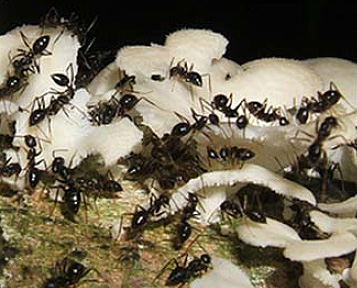
Euprenolepis procera
(photo by Witte and Maschwitz)
This is cool. A new paper by Volker Witte and Ulrich Maschwitz details a previously unknown behavior for ants: nomadic fungivory. Here's the cite and the abstract:
Witte, V. and U. Maschwitz. 2008. Mushroom harvesting ants in the topical rain forest. Naturwissenschaften, online early.
Abstract: Ants belong to the most important groups of arthropods, inhabiting and commonly dominating most terrestrial habitats, especially tropical rainforests. Their highly collective behavior enables exploitation of various resources and is viewed as a key factor for their evolutionary success. Accordingly, a great variety of life strategies evolved in this group of arthropods, including seed harvesters, gardeners, and planters, fungus growers, nomadic hunters, life stock keepers, and slave makers. This study reports the discovery of a new lifestyle in ants. In a Southeast Asian rainforest habitat, Euprenolepis procera is specialized in harvesting a broad spectrum of naturally growing mushrooms, a nutritionally challenging and spatiotemporally unpredictable food source. While unfavorable to the vast majority of animals, E. procera has developed exceptional adaptations such as a shift to a fully nomadic lifestyle and special food processing capabilities, which allow it to rely entirely on mushrooms. As a consequence, E. procera is the most efficient and predominant consumer of epigeic mushrooms in the studied habitat and this has broad implications for the tropical rainforest ecosystem.
- Log in to post comments

This article got me thinking that we really have no idea what it is most plagiolepidine ants, including Paratrechina and Brachymyrmex, actually eat. (Indeed, this true for most ants.)
Back in the early 1980s, I think, there was a paper by Catherine Thompson, (in Florida Entomologist?) reporting the presence and possible relationship between ants and cixiid hemipterans (Fulgoroidea), in the nests of P. arenivaga. Cixiids are unusual in that they feed from hyphae rather than from phloem.
I wonder if anyone wants to analyze crop contents of litter-dwelling plagiolepidines for evidence of fungal products.